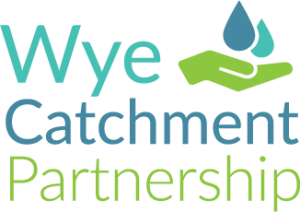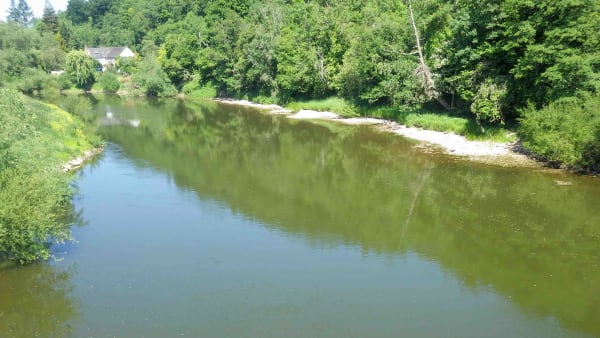Tuesday 7th July, 2020
So claimed Natural Resources Wales, following our press release last month on the severe algal blooms affecting the Wye.
Sunlight and low flows are two of the ingredients needed for a bloom and both were certainly present this spring (the former in record amounts). However, as many will have seen, Wales’s environmental regulator has attributed the greening of the river Wye to those two factors alone. They contradicted our assessment that increased amounts of phosphate entering further upstream in the river were a factor too, pointing instead to apparently falling levels of phosphate across the Wye catchment as a whole.
This view has emboldened the reaction to the Wye algae news story, especially from those who have a vested interest in maintaining the status quo. It has led to the Foundation being labelled “reckless” in the agricultural press with accusations of us portraying a “gross misrepresentation” of the situation and having an ‘agenda’. It appears that our highlighting of environmental damage has been perceived by some as an attack on the farming community as whole.
To repeat our press release, we have never blamed farmers for the increasing severity of Wye algal blooms. We believe the cause is flaws in the planning and regulation processes. Farmers have been let down by the same systemic failure that the river Wye has.
We have never blamed farmers for the Wye’s algal blooms. They have been let down by the same systemic failures that the river has
Natural Resources Wales are the body that advises Powys County Council on all planning applications. By law, they have to be certain that each planning application in isolation and in combination will not damage the Wye Special Area of Conservation. This consideration of cumulative effects of intensive livestock units was something the Planning Inspectorate reminded all Welsh Councils about in June 2018. Since then, a further 15 intensive poultry units have been approved in the upper Wye and Lugg catchments.
Does Natural Resources Wales’s monitoring afford them this certainty? That is something we have asked them but in the meantime, work undertaken by Environment Agency, Welsh Water and Natural Resources Wales themselves suggests it does not.
In April this year, SAGIS (Source Apportionment Geographical Information System) modelling used to determine Welsh Water’s investment plan, found that the amount of phosphate in the Ithon has increased markedly and is now comparable to the Lugg, a river whose own elevated phosphate levels have led to a moratorium on any planning being approved in north Herefordshire. The Lugg also generates an algal bloom every year in which the climatic conditions are right.

The lower reaches of the river Lugg (Wye tributary) at Mordiford last month displaying a severe algal bloom. The Ithon now contains a comparable level of phosphate to this river and both turn green every year in which climatic conditions are right.
The claim that the Wye’s blooms are down to sunshine and low flows alone needs some scrutiny too. If that were the case, why was this year’s algal bloom only witnessed in the Ithon and main Wye downstream of their confluence? Neither the Irfon (the other major upper Wye tributary) nor the main river upstream of the Ithon confluence went green. SAGIS modelling shows that, unlike the Ithon, both these areas of the Wye catchment remain under the level of phosphate needed for an algal bloom to develop.
In 2018 and 2019 the Wye suffered similarly severe algal blooms that started in the lower Ithon. However, in neither year was there a record for spring sunshine. There must be something else at play other than just light and flow when it comes to the generation of the river’s algal blooms. The wealth of scientific research suggests that high phosphate levels act as a significant factor determining the onset and extent of an algal bloom.

The other major upper Wye tributary, the Irfon, was subject to the same levels of sunshine and low flows this spring as the Ithon yet it did not experience an algal bloom.
The Foundation will continue to do what we can to reduce the amount of phosphate entering the two rivers by working with farmers and the wider food supply chain within the Wye and Usk catchments. This is not an easy task, especially in light of our press release being taken as an attack on the agricultural sector.
Amongst other things, we are running several projects that will reduce the risk of nutrients entering our rivers. We are already working in partnership with Tesco, World Wildlife Fund and Noble Foods. This provides free range egg suppliers with the opportunity to install measures such as wetlands to reduce risk of runoff or drainage from a site entering a watercourse. Wetlands are, of course, expensive to retrofit. They also require space that is not always available and can pose biosecurity risks. It would have been far easier for everyone, especially farmers, to have them included as part of the planning process and installed at the building stage. The poultry range areas that have streams running across them will be more of a challenge to fix.
Powys’s planning process is one that is designed to pollute and one that benefits no-one, least of all farmers
But this will not solve the problem on its own. We need Natural Resources Wales and Powys County Council to do their job. They are the ‘competent’ authorities that have been charged with protecting the Wye Special Area of Conservation, designated as such because of its nationally and internationally important habitats and ecology. Presently, for every farmer we work with the Council approves more poorly located and designed poultry unit planning applications, based on Natural Resources Wales’s advice. It is a planning process designed to pollute and one that benefits no-one, least of all the farmers who rely on authorities carrying out their legal duties.
Encouragingly, the attention this issue has gained in the national media has had an effect, as have so many of you writing to AMs and MPs on the issue. Both Natural Resources Wales and Powys County Council are at least now acknowledging a problem that has been staring the rest of us in the face. But we all need to continue applying pressure, to stop further ecological deterioration of the Wye and to prevent this issue being kicked into the long grass of another Welsh Government committee.
Finally, we would like to say thank you to all those who responded to the press release and previous e-news on algae. We are very sorry that we could not answer everyone individually but it is always heartening to be reminded that there are so many people who care as much about the health of the rivers as we do.



